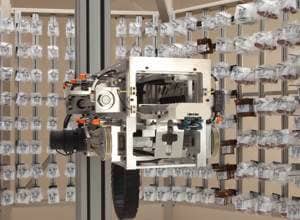Meet ROBOT-Rx, The Robot Pharmacist Doling Out 350 Million Doses Per Year

Share
Come to think of it, why do we still have pharmacists? I mean, how hard is it to count by “twos”? I’m just kidding of course. You probably want that extra pair of human eyes to check on your prescription. But after the pharmacist has double-checked the prescription and answered your questions, why not let robots count the pills out for them?
Meet ROBOT-Rx, the automated medication dispensing system. Made by medical technologies supplier McKesson Corp, ROBOT-Rx is like the vending machine of the future, except it hands out drugs instead of candybars. And it might surprise you to know that over a third of medium and large hospital pharmacies in the US are already using ROBOT-Rx to fill 350 million medication doses each year.
The robot automates every step – except prescription, humans still do that, for the time being. But storage, selection, return, restock, and record-keeping are all carried out by ROBOT-Rx. And as you might imagine, ROBOT-Rx doesn’t make a lot of mistakes, filling medications with a 99.9 percent accuracy, according to the company. Pharmacists reduce their need to double-check orders by 90 percent, missing medications are reduced by 92 percent, and inventory is lower. In the end, ROBOT-Rx saves the hospital 54 percent on medication costs.
The medications are placed in envelopes or cassettes with bar-codes that links it to the computer record of the patient and updates the drug inventory as prescriptions are filled. And even it doesn’t merely count by twos. With its Fill Mode logic function, ROBOT-Rx prioritizes orders and fills them in the most efficient sequence.
Here’s a video of the robot pharmacist. I failed to mention one other reason why a robot pharmacist is perfect for the job. As one of the McKesson employees point out, “It’s also not bored, it likes doing this.”
Be Part of the Future
Sign up to receive top stories about groundbreaking technologies and visionary thinkers from SingularityHub.


If medical errors are one of the leading causes of death, and medication dispensing errors account for 21 percent of all medical errors, then higher accuracy through robots would be a welcomed change. It's happening, and not just with ROBOT-Rx. Both the University of California, San Francisco's Automated Pharmacy and the PillPick system at New Jersey's Holy Name Hospital work 'round the clock filling thousands of doses each day.
The end result of greater back end automation will be to bring the pharmacists to the front, allowing them more time to interact with patients and answer doctors' questions. As they introduce robotics into production lines, companies are quick to say the robots won't take away jobs, that it frees up people for more skilled tasks. At least for the pharmacist, this seems to be true.
As for the pharmacists' technicians, however....
[image credits: McKesson Corporation]
[video credit: McKesson Corporation via YouTube]
images: McKesson Corporation
video: McKesson Corporation
Peter Murray was born in Boston in 1973. He earned a PhD in neuroscience at the University of Maryland, Baltimore studying gene expression in the neocortex. Following his dissertation work he spent three years as a post-doctoral fellow at the same university studying brain mechanisms of pain and motor control. He completed a collection of short stories in 2010 and has been writing for Singularity Hub since March 2011.
Related Articles

This Light-Powered AI Chip Is 100x Faster Than a Top Nvidia GPU

These Robots Are the Size of Single Cells and Cost Just a Penny Apiece

Hugging Face Says AI Models With Reasoning Use 30x More Energy on Average
What we’re reading
